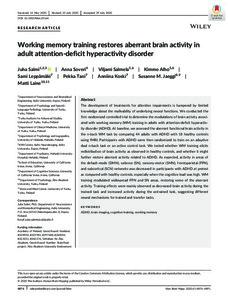Working memory training restores aberrant brain activity in adult attention-deficit hyperactivity disorder
Salmi J; Soveri A; Salmela V; Alho K; Leppamaki S; Tani P; Koski A; Jaeggi SM; Laine M
Working memory training restores aberrant brain activity in adult attention-deficit hyperactivity disorder
Salmi J
Soveri A
Salmela V
Alho K
Leppamaki S
Tani P
Koski A
Jaeggi SM
Laine M
WILEY
Julkaisun pysyvä osoite on:
https://urn.fi/URN:NBN:fi-fe2021042821751
https://urn.fi/URN:NBN:fi-fe2021042821751
Tiivistelmä
The development of treatments for attention impairments is hampered by limited knowledge about the malleability of underlying neural functions. We conducted the first randomized controlled trial to determine the modulations of brain activity associated with working memory (WM) training in adults with attention-deficit hyperactivity disorder (ADHD). At baseline, we assessed the aberrant functional brain activity in the n-back WM task by comparing 44 adults with ADHD with 18 healthy controls using fMRI. Participants with ADHD were then randomized to train on an adaptive dual n-back task or an active control task. We tested whether WM training elicits redistribution of brain activity as observed in healthy controls, and whether it might further restore aberrant activity related to ADHD. As expected, activity in areas of the default-mode (DMN), salience (SN), sensory-motor (SMN), frontoparietal (FPN), and subcortical (SCN) networks was decreased in participants with ADHD at pretest as compared with healthy controls, especially when the cognitive load was high. WM training modulated widespread FPN and SN areas, restoring some of the aberrant activity. Training effects were mainly observed as decreased brain activity during the trained task and increased activity during the untrained task, suggesting different neural mechanisms for trained and transfer tasks.
Kokoelmat
- Rinnakkaistallenteet [27094]
